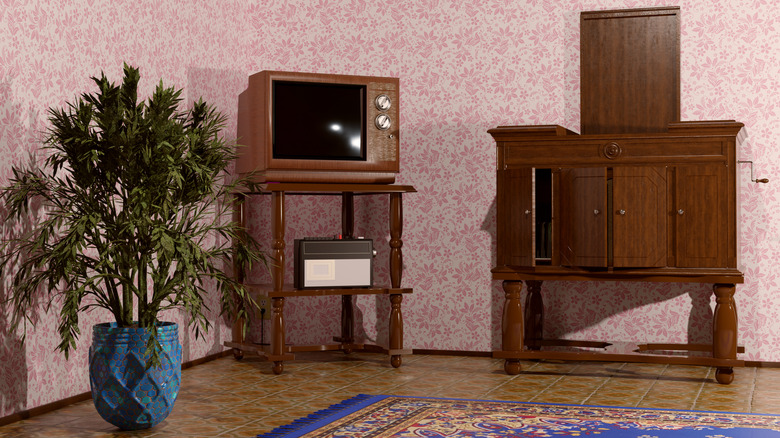The Vintage Design Trend That's Coming Back (And How To Get The Look)
Decades ago, many people imagined a future full of sleek chrome, digital designs, and maybe even holograms — but while there are plenty of modern advancements in today's world, many design trends are actually taking cues from the past. There are tons of retro designs making a comeback, proving that vintage trends are always worth reconsidering. Oftentimes, home designs are in alignment with fashion in terms of trending styles, like the soft, striped linen fabrics that create a coastal look, or vibrant color blocking designs. That said, sometimes the runway is the best place to look for emerging trends in home decor. We're seeing it happen today, with the fun and flirty vintage trend that has been seeing a revival in both clothing and home design — polka dots.
This trend might remind you of the vintage polka skirts from the '60s, but now the pattern is making a new name for itself in modern decor. There are many reasons that polka dots are beginning to rise again in popularity, and they're worth considering for your next home refresh. It may be a vintage look, but there are plenty of ways to incorporate this trend into modern decor to give your space a stylish yet nostalgic aesthetic.
Polka dots are back in style
Home design trends have been seeing an exciting shift lately, moving away from stark minimalism in favor of more dimensional designs. While many trends reflect an enthusiasm for maximalist decor, many homeowners aren't ready to veer too far from more simplistic, neutral designs. In either case, polka dots can offer a stylish solution. It's a versatile pattern that can be used to add subtle, sophisticated visual interest to neutral interiors, or further elevate more eclectic and vibrant spaces. It's a simple design that can adapt to different styles with the use of color and scale, allowing you to find the perfect balance for your space.
One of the biggest worries with trending styles is that they'll one day fade out of the spotlight and leave your home looking outdated, but some designers insist that polka dots can be just as timeless as they are trendy. Polka dots are seen as a classic style, but they also offer a fun and fresh geometric element, making it a perfect approach to elevate home decor. They're similar to stripes in the sense that they can be seen as classy and chic, but with different color ways and experiments in sizing, they can feel more playful and vibrant. Although the pattern is a revival from past decades, with the right approach, it can add a stylish look that feels current in your home for years to come.
How to embrace polka dots in your home
There are many ways to incorporate the polka dot trend into your home decor, both with big, bold statements, and subtle styles. Before you commit to an approach, consider what kind of impact you want them to have on your design. The scale and shape will have a significant impact, whether you're arranging uniform sized dots in a gridded pattern, or hand-painting larger dots on your wall for an organic look. As for the colors, playing around with a few contrasting, vibrant shades will create a playful look throughout the space. Designers recommend using neutral schemes like black and white for a refined look, however, colorful palettes can work in small doses where vibrancy is needed.
An easy way to dip your toe into the trend is through interchangeable fabrics like bedding, throw pillows, curtains, or rugs. These simple additions are easy to align with solid decor elements and natural textures. Through smaller accessories, layering different types of polka dots with other patterns like florals and stripes can add character to your space without clashing. If you want to start small, adding touches of the pattern throughout decor or accent furniture can be a good place to start, but for a big statement, you can use the pattern in large elements like carpeting, flooring tiles, or wallpaper. In either case, designers recommend being thoughtful about your application rather than going overboard with the pattern, so it's easier to complement within your design.
